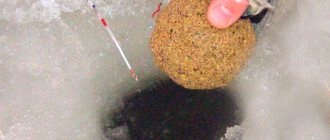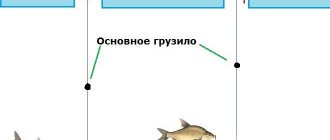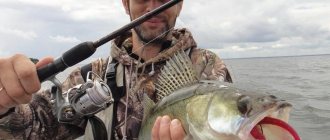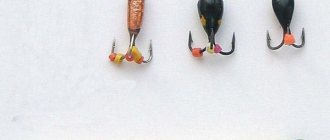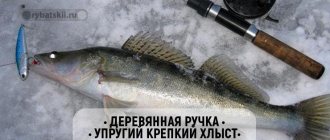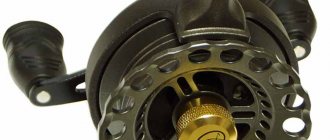Pike perch - features of the species
Pike perch is one of the most popular predators of the perch family: it is a desirable prey for many anglers, regardless of their experience. It can be found in unpolluted and environmentally friendly reservoirs that are well enriched with oxygen.
Today there are 5 main species, which differ slightly in color and habitat.
All of them have the following features:
- Impressive body size, the length of some individuals can exceed a meter.
- Weight depends on size , the average is 10-15 kg, although sometimes it is possible to catch trophy specimens weighing more than 20 kg.
- The head has a flat and elongated shape.
- The scales evenly cover the entire surface of the body.
- The color depends on the variety of pike perch , the most common are individuals with a gray-green body, the abdominal part is painted in white-gray tones.
- There are faint spots on the sides with a brownish tint; they are usually localized in the center and form stripes characteristic of this fish.
- Canine teeth are located on the upper and lower jaws and this is one of the signs by which the gender of a pike perch can be determined: males always have larger teeth.
How to catch pike perch in winter?
To obtain an impressive catch, it is necessary to take into account some features of winter fishing for pike perch.
The most significant rules are as follows:
- Pike perch is most active in the late evening or night hours , but if necessary, it also goes hunting during the day. In winter, this often happens, especially when there is a lack of food in the reservoir.
- The baits and lures used should be well buried , since pike perch prefers to hunt near the surface of the bottom, rarely rising to the middle water layers or to the surface. This is due to the fact that it is in such places that forage fish live, since even during the most severe winters the temperature there remains up to +4°C.
- It is necessary to find a suitable fishing point ; if there are no bites for a long time, the place changes, since pike perch stays in schools, and low activity indicates its absence. An exception is made for situations when trophy specimens that prefer a solitary existence are purposefully searched for.
- When choosing a fishing point, it is necessary to give preference to areas with a hard bottom with a sandy or gravel surface; in the winter season, pike perch rarely leaves such places.
- The presence of snags , flooded trees and other similar underwater obstacles that serve as hiding places for predators greatly increases the likelihood of a bite.
Where to look for pike perch
One of the main problems when catching pike perch in winter is finding it. During moments of active biting, it does not stay in one place, but moves around the reservoir in search of fry. Closer to the dead winter, it moves to wintering pits, but then its bite becomes very sluggish. Fortunately, its migrations have certain patterns, and in addition, when searching, you can use a number of natural clues.
The tactic of searching for pike perch consists of constantly moving across the ice of a reservoir and drilling new holes. Even if you find it, it’s not a fact that the bite in this place will continue.
The following signs can help in finding it:
- Pike perch can be found with the help of local fishermen, either using their advice, or by following tracks in the snow, focusing on a crowd of fishermen. Here the pack instinct will help you. But you should not linger around the groups, if there is no bite for some time, it is better to continue an active search.
- Moving around the reservoir, this fish still sticks to the same places, and if you have caught pike perch here before, then there is a high chance of catching it again in this place.
- If you know a body of water, use that to look for walleye on your own. During the first ice, it will peck in the same places as at the end of autumn. Hunting for small fish, pike perch moves along spits, dumps near shallows, edges, and exits from holes. Often comes out onto the shallows themselves.
Important: When searching for pike perch, you need to remember that it prefers hard types of bottom - sand, stones, and does not like muddy areas.
- Later, pike perch can be found at depth, among snags, in holes, along old channels and underwater ditches, at the base of underwater slopes and elevations.
- Closer to spring, it moves to places rich in oxygen, and, accordingly, in prey. These are the confluences of rivers, streams, areas along the current where you can hide from it.
So, on large rivers like the Volga, Ob or Don and their reservoirs, most of the winter you should look for pike perch at depths of at least two to three meters. Usually, the places where pike perch bite are well-trodden by fishermen, and to find it, it’s worth moving between clusters of old holes above the depths. Such places are clearly visible from afar, since the snow above them is darker and trampled, and the ice cover is looser and lumpier.
If we take the rivers as a whole, the most pike-perch place on the Ob is considered to be the area of the village of Pervomaiskoye, where the Chulym River flows nearby. It is good to catch pike perch near Tomsk.
On the Volga, among fans of winter fishing for pike perch, the following are popular: the Volgograd Reservoir, near the villages of Peskovatka, Olenye, Gorno-Vodyanoye, Gornaya Proleika, Gorny Balykley; Proran - a channel in the area of the village of Kamenka, Nizhny Novgorod region; the village of Vasilursk, near the confluence of the Sura; island water area of the Volga River near the village of Bezvodnoye, Nizhny Novgorod region, etc.
On the Don there is a good bite for pike perch on the Tsimlyanskoye Reservoir, as well as in the area of the Vertyachiy farmstead, Volgograd region.
Tackle for catching pike perch in winter: secrets of anglers
It is important to know not only where to catch pike perch in winter and how to correctly determine the place for fishing, but also what gear to use for this.
They must meet the following requirements:
- All parts and elements of gear must be made of frost-resistant materials to withstand even the lowest temperature conditions. Today on the fishing market you can find many specialized models designed for winter fishing and fishing in extreme climatic conditions.
- The gear must be powerful enough and capable of withstanding significant loads, since it will need to suppress the resistance of a large and strong predator, which does not weaken in the cold winter period.
- The diameter of the working line must exceed 0.2 mm , otherwise the risk of breakage increases at the most inopportune moment when fishing for prey.
- The optimal length of the fishing rod is 80 cm.
- Choosing the right bait is no less important than setting up the gear. Here, anglers are given some freedom, since they can choose balancers, spoons, various types of live bait or frozen animals. A good and stable bite is often observed when fishing with live sprat or sprat.
- Hooks for equipment must be made of durable and reliable material and have large dimensions, taking into account the strength and size of the pike perch.
- Reels that are equipped with winter gear usually have larger sizes.
Many fishermen are looking for suitable places for winter fishing even during the summer season; for these purposes, echo sounders are used to assess the terrain and bottom structure. It is recommended to compare the obtained data with maps.
Techniques for catching pike perch using rattlins in winter
The technique of fishing with vibrations is not that much, but it differs from fishing with vertical spoons or balancers. It is smoother and more leisurely, without sudden sudden jerks and shifts.
Having lowered the bait under the ice, first of all you need to feel the bottom. All rattling work is carried out in the bottom layer no higher than a meter from the bottom.
Smooth game
Used for sluggish biting and passive predator:
- raising the bait above the bottom by 10 - 20 cm, swing it;
- gently rocking we raise it to a height of up to half a meter;
- We do a few swings at the top point and gradually lower it back.
Active game
Used if pike perch is actively feeding:
- gradually accelerating, we raise the rattlin to the top a meter from the bottom;
- at the top point we make several small twitches;
- we reset the vibe down with several short stops;
- pause in the lower position.
Playing with a jig
We move the rattlin vertically to different depths by 20–30 cm, oscillating where it stops, like using a jig for perch fishing. We move the bait between levels smoothly.
When using different types of games, you need to take into account that each rattlin model has its own characteristics. Therefore, the wiring must be selected individually for each of them and used first. The more active the predator is, the more active the game should be, but in any case it needs to start with several energetic movements. By the way, all these techniques can be used in the summer, when trolling vertically from a boat.
Peculiarities of feeding behavior of pike perch in winter
Feeding behavior changes greatly with the onset of winter, so the following features must be taken into account:
- Depending on weather conditions in late autumn or early winter, pike perch actively feeds . The main prey is bleak, redfish and other schooling fish, which the predator presses against the first ice for ease of fishing. At this time, he is hungry, so fishing can also be very effective.
- Gradually, cold weather affects the pike perch's body , slowing down its natural metabolic processes, which also affects appetite. The predator no longer requires a significant amount of food, behavior becomes more passive and the bite also decreases.
- The lack of need for a large amount of food leads to the fact that the pike perch stops moving around the reservoir, so you should look for places where it permanently stops.
- Pike perch is highly dependent on weather conditions ; for this reason, it may lose its appetite during sudden changes in atmospheric pressure, during severe snowstorms or a premature thaw.
- In the first half of winter, pike perch bite best on clear frosty days , but the picture completely changes by the end of January or beginning of February. The behavior of the predator becomes more aggressive, it experiences hunger more often and goes out hunting.
Correct rigging
Now let's look at the rigging of a rod for rattlin fishing.
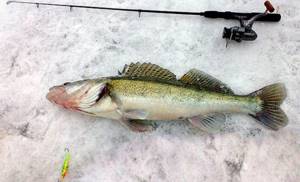
Fishing rod
For winter fishing for pike perch using wobblers, it is best to use a simple fishing rod with a hard, reinforced whip. It can be taken from an old, Soviet spinning rod. Such a fishing rod will allow you to feel the slightest bite and make a powerful, hard hook. The length of the whip is preferably about 40 cm. The nod is not particularly necessary, since the bite can be felt by hand.
Coil
To catch pike perch on a fishing rod, it is most practical to use a large inertial reel . It is simple, quite light, and allows you to easily operate the gear at different depths.
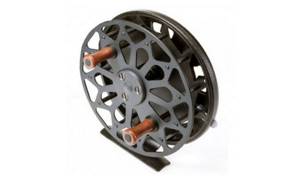
Inertia coil
fishing line
For this, it is best to use a braided cord with a diameter of 0.1 -0.15 mm. This thickness is enough for you to pull out even a trophy specimen. Due to its low elasticity, it perfectly transmits the slightest touch to the bait. In addition, any trembling of the hand will be transformed into a vibration movement.
Sinker
The sliding sinker is loosely placed on the main line when fishing at great depths or currents. Its weight varies from 3 to 15 grams.
Leash
It is installed in cases where you have to operate in snags, etc., and there is a possibility of getting caught when fishing. The breaking load of the leash should be 30 percent lower than the main line. We choose the length of the leash depending on the intensity of the bite.
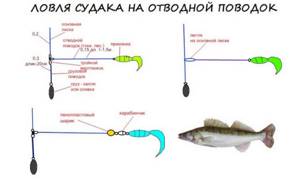
In addition to all this, we equip the fishing rod with a carabiner with a swivel, to simplify the change of vibrations while fishing.
Video: making a winter pike-perch fishing rod
Methods for ice fishing for pike perch
There are only two main methods for underwater fishing for pike perch, their features are as follows:
- Using baits in the form of live or dead fish . To do this, you will need to have a special winter fishing rod equipped with an oversized reel. You can use jigs, as well as standard tackle with jigs or spinners equipped with a large hook on which the nozzle is placed. Many anglers practice catching pike perch with a worm; usually this method is effective at the end of winter, when a slight thaw begins and melt water penetrates the reservoir.
- An alternative method is to use artificial baits , most often fish made from foam rubber or silicone worms are used. You can use classic options in the form of spinners and balancers; ratlins, which are a winter variety of wobblers, are becoming increasingly popular.
Fishing for pike perch in winter using lures - lure lessons
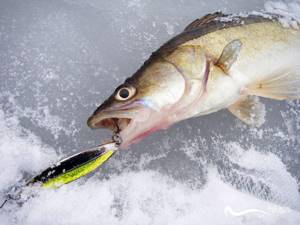
Despite the appearance of a large number of modern baits, spinners have still not lost their popularity in winter fishing for pike perch. For these purposes, you can use the same models that are intended for ice fishing for pike, since they have all the necessary parameters.
Other features of the selection and use of spoons for catching this predator are discussed below:
- The chosen spinner must have impressive weight and size , since it will have to be used at considerable depth.
- You should not make sharp swings and create a significant amplitude of oscillations while playing with the lure; pike perch does not like this behavior of the prey.
- To ensure a good bite, the spoon should move slowly or generally be in a stationary position, slightly swaying from side to side.
- The tee with which the spinner is equipped can be modified by attaching several red feathers or wool of the same color.
- Castmaster spinners are the most effective ; homemade heavy triangular spinners also performed well.
Catching pike perch in winter on zherlitsy - easy fishing with a bite alarm
Winter fishing with girders is an old technique that has proven itself on the positive side, which is why it is still practiced by many fishermen.
The main features of its use are given below:
- The installation of girders is carried out near deep places where accumulations of pike perch were previously discovered.
- Sometimes a good catch can be obtained when fishing in shallow water ; usually for this, a trap is placed all night if favorable conditions are observed for the predator to emerge from cover.
- The design of the gear is exactly the same as that of a pike harness ; you can avoid using a metal leash, since there is no particular need for it.
- It is recommended to use gudgeon as live bait ; it should be placed directly near the bottom surface.
- Dead fish are used as bait if you have to catch pike perch in places with rapid currents.
Knowing how to catch pike perch in winter using girders, you can increase your chances of catching, since these same capabilities are also suitable for fishing for another popular predator - pike.
Catching pike perch on a balance beam - in search of happiness
How to catch pike perch in winter using a balance beam and still get a significant catch, you can find out below:
- It is necessary to avoid tight knots when attaching the balancer , since they will interfere with the ease and smooth movement of the bait, which is so important when fishing for pike perch.
- It is recommended to use models with bright colors . Dull balancers may not interest pike perch in the cold winter, but a bright shade will immediately attract his attention and provoke him to attack.
- When using balancers, it is necessary to carry out sharp and sudden hooks ; the activity of the fisherman during the fishing process is the key to a good catch.
Catching pike perch in winter with ratlins - features
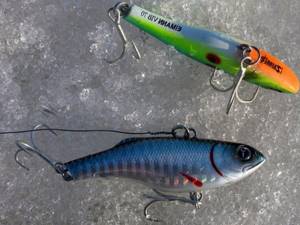
Ratlin is a winter type of wobbler; this bait accurately copies the appearance and behavior of a fry, attracting the attention of pike perch to defenseless prey. There are no special features in the fishing process, so this option is recommended for beginners who are just beginning to master the specifics of winter predator fishing.
There are only two points to consider:
- Ratlins are not recommended for use at depths of more than 6 meters , due to their too low weight.
- There is a wide range of ratlins on the market ; they are all effective under certain fishing conditions, so it is better to consult with specialists first.
Catching pike perch in winter with a jig - be patient
Jig baits are also popular during winter fishing for pike perch, as they allow you to explore significant depths, which are the refuge of this predator.
When using a jig, the following features must be taken into account:
- If it is necessary to immerse the jig to a very great depth , additional weights will need to be attached to the tackle.
- The wiring must be carried out sharply , but at the same time carefully, without creating too chaotic movements and a significant amplitude of vibrations.
- If there is no bite, you need to try the same wiring method many times in one place. In winter, pike perch often show increased caution and you can simply watch the jig for a long time, and after its systematic appearance at depth, make an attack. For this reason, this fishing method is suitable only for patient fishermen who have a lot of time.
Catching pike perch in winter with a cicada - a competent old man
Cicada is one of the modern varieties of spinners; it often demonstrates a high degree of efficiency during winter fishing. Its main feature is its increased stability and special body shape, which allows it to compete on equal terms with live baits.
When choosing a cicada, it is important that the spoon meets the following criteria:
- Large size and weight, since significant depth will be required.
- High load share.
- Small blade size.
Catching pike perch in winter on the current - fishing secrets
Fishing on a fast current is usually carried out if a river is chosen for fishing.
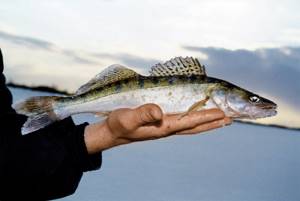
Finding a suitable place that could be a refuge for a predator can take a lot of time, so you need to know the following rules and features:
- There is no need to move along the entire river ; it is enough to choose a position near an area where pike perch frequently passes, and wait there for the predator. In the river space it is much more active.
- The length of the tackle should be about 30 cm , the main selection criterion is increased rigidity.
- Balancers with good stability are used as bait ; sprat can also be used.
Many fishermen ask the question of how to catch pike perch in winter using sprat with a rapid current, but there are no specific features here: the process occurs in the same way as in reservoirs with stagnant water.
Catching pike perch at night in winter - features of catching trophy specimens
Many fishermen set themselves the goal of catching a trophy specimen; compliance with the following conditions can increase such a chance:
- Fishing should be carried out at a depth of about 3 meters.
- For fishing, you need to choose night hours, when single large individuals are more active.
Otherwise, fishing is carried out according to the standard scheme, but it is recommended to take already tested gear with you. Given the conditions during night winter fishing, there will be virtually no opportunity to master and adapt to a new fishing rod.
Active fishing with dead fish
This fishing method involves using jigs equipped with a large and reliable hook. It is used to add additional bait in the form of a dead fish. Most often, lightly salted or fresh sprat is used for these purposes, which pike perch bites well on.
You can use only the tail part; this method can be used not only when fishing with jigs, but also when using balancers or spinners.
The main features and rules of such fishing are discussed below:
- The game of bait with a planted dead fish should be distinguished by its ease and smoothness; too sharp and sudden movements are ways to scare off a predator; It is not recommended to make significant fluctuations.
- The most effective game for attracting the attention of pike perch is a smooth rise of the bait with a nozzle; while lowering it to the bottom surface, you can make very slight vibrations that will resemble vibration.
- You can use jig baits , the fishing features in this case rarely differ from summer fishing, but still show excellent results in the form of a significant catch. As a bait, you can use not only sprat, but also capelin, sprat and any other small fish that you can get.
- Team fishing is most effective , rather than solo fishing for pike perch.
Catching pike perch with winter fishing rods
Winter girders are used to catch pike perch from the ice; this is a very old method, the popularity of which has returned in recent years.
It is capable of bringing an impressive catch if the following basic rules are observed:
- The absence of a metal leash that can scare off a cautious predator.
- Using gudgeon as bait.
- Using dead fish when fishing for pike perch in places with fast currents.
- Fishing at night.
- The installation of girders is carried out near the bottom; it is best to choose places close to the discovered pike perch holes.
Winter fishing for pike perch using ratlins and soft baits
This method of catching pike perch is highly exciting and belongs to one of the types of sport fishing.
For a long time it was believed that ratlins demonstrate a high degree of efficiency only when used at a depth of 4-5 meters , however, today the fishing market is ready to offer a large number of different modifications, which allows you to select the most suitable soft baits for specific fishing conditions.
The use of jig heads has not yet become a widespread practice, but they are gradually being used by an increasing number of fishermen who are aware of modern trends.
Catching pike perch in winter using sprat
Winter fishing for pike perch using sprat is most effective when the predator is passive, since it is attracted by its natural smell. Another advantage of this bait is that it can be used frozen, which eliminates all the problems associated with storage.
It is recommended to consider the following tips:
- A common mistake is to use sprat that is too large ; the optimal size is 5cm. This bait is suitable for fishing out medium-sized predators, but at the same time there is still the possibility of catching larger individuals.
- You should not use too many hooks , since although this increases the number of bites, it also increases the risk of cliffs if you get caught on the lower edge of the ice.
- When fishing for pike perch in fast-flowing waters, the sprat should be placed across the body, which allows you to demonstrate a more interesting and active game that will certainly interest the predator.
- When using heavy jigs, the sprat is planted only by the tail or head. If you use double-hook jigs, then you need to place the bait on both hooks at once so that it has the shape of a half ring.
Fishing Features
The main secret to catching pike perch in winter is a successful search. All strength and initiative must be thrown at him. If a fish is found, catching it is not a problem (except for periods of complete passivity, which is unpredictable. The fanged fish is a greedy and aggressive predator. Of course, the technique of catching pike perch in winter has its own specific characteristics.
Nocturnal lifestyle
The object of the catch is a typical nocturnal predator. Short hyperactive outbursts (especially in summer) are also observed at dawn. But they may not exist. If a fisherman has the opportunity to visit a reservoir many times, then the rhythms of the fish coming out to feed need to be determined and studied. Comparison of the correctly found place and exit time is the key to a bite. Catching pike perch at night is initially more catchy than during the day.
During daylight hours, fish are looked for passively standing in the pit. The fish may bite; you need to throw the bait directly to the point where it is standing. At night, pike perch actively hunts, using its lateral line. He senses vibrations from afar, so the range of action of one hole expands significantly. Therefore, if possible, it is better to use night fishing.
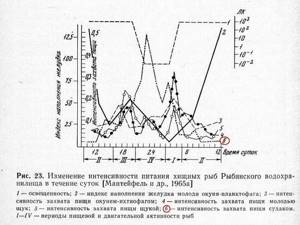
Search and catch mode
When the fishing location is known in advance (at old points), especially during the day and in the dead of winter, a thorough search tactic is used. The point is precisely known, the predator is most likely passive, so you need to catch literally every meter. Holes are drilled quite often (for example, every 2-4 meters), carefully fished using various winter baits and fishing rods.
In other cases, in winter (the points are unknown, fishing at night, the fish are at least somehow active), the travel mode is used. There are many holes in the maximum number of promising places with quick fishing with the most catchy tackle and bait. This approach is the most appropriate - the more area of the reservoir that has been explored, the higher the likelihood of finding this predator in winter.
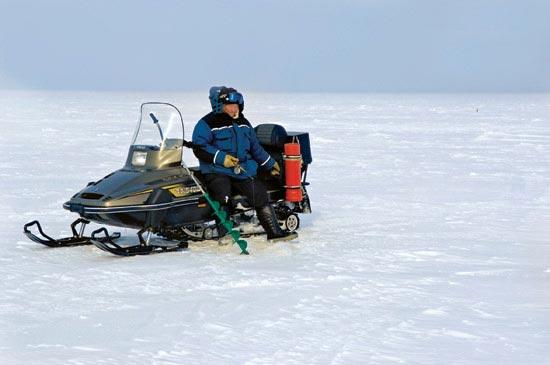
Bait game
In winter, the fanged one loves pauses. Regardless of what kind of bait is used, a balancer, a spinner or a ratlin.
- Movements during fishing should be smooth, pauses should be long.
- A passive predator reacts well, for example, to heavy nails, which practically do not play, but simply walk up and down.
- Pike perch does not like too lively game, like other predatory fish. Bites occur more often after a reset, when the bait is lowered, at the end of a long pause.
- In any case, the length of pauses and amplitude of movements are established experimentally. Once the point has been found, the correct fishing time, adjusted gear and the right game, winter fishing for pike perch turns into simply getting the fish out of the hole.
- The bite is expressed in knocking, jerking or hanging weight. The hook is made strong and confident - to cut through the bone mouth.
- Sometimes a predator grabs the bait and clamps it with its jaws, without being detected and holding it to the end. Therefore, when fishing from ice, you need to fish quickly. Frequent cases are the spoon falling out of the fish’s mouth after being taken out of the water.

Fishing on the Volga
The Volga is a river that attracts many fishermen.
However, fishing for pike perch on it has some fundamental differences that must be taken into account:
- On the Volga there is a mighty water stream that has a complex principle of movement.
- The Volga has a very developed food supply . The diversity of microorganisms attracts a large number of fish, which become prey for this predator, so it rarely experiences hunger.
- The length of the river provides a variety of underwater terrain and depths, so it is necessary to immediately decide in what conditions the pike perch fishing will take place. It is better to go for trophy specimens in the summer rather than in the winter, since in the warm months the predator can be caught by trolling if you have a swimming device.
Winter fishing rod
The main criterion when choosing a winter fishing rod is its frost resistance, since even correctly selected baits and high-quality equipment will not help you get a good catch if the tackle is not able to withstand low temperature conditions.
Particular attention is paid to the fishing line: it must be additionally coated with polymer resin , otherwise the cord becomes covered with ice and breaks very quickly.
When using jigs, you need to make sure that they are marked with luminous paint, which is especially important when catching pike perch, which sees very poorly when at depth.



